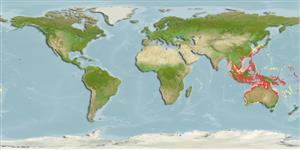Environment: milieu / climate zone / depth range / distribution range
Écologie
marin récifal; profondeur 1 - 55 m (Ref. 37816). Tropical
Western Pacific: Japan to Australia, including Guam and Palau.
Taille / Poids / Âge
Maturity: Lm ? range ? - ? cm
Max length : 30.0 cm TL mâle / non sexé; (Ref. 3132)
Épines dorsales (Total) : 4; Rayons mous dorsaux (Total) : 8; Épines anales: 0; Rayons mous anaux: 7. Identified by the finger-like separate first rays of the ventral fins, and distinguished from the similar D. kuiteri in usually having 8 divided rays in the second dorsal fin (versus 9), the fin with a distinct horizontal pattern of lines in adults, and males have long filaments on the first dorsal fin (versus short or absent) (Ref. 48636). Body moderately depressed. Preopercular spine with processes on both inner and outer sides. Pelvic spine and 1st pelvic ray fused into an elongate rod, separated from the other pelvic rays. Attains 10 cm SL.
Lives on sand-weed bottoms (Ref. 559). Inhabits protected sand and mud flats and slopes at depths of 1 to 55 m (Ref. 37816); also include estuaries and deep water (Ref. 48636). May be seen solitary or in pairs (Ref. 90102).
Life cycle and mating behavior
Maturité | Reproduction | Frai | Œufs | Fécondité | Larves
Masuda, H., K. Amaoka, C. Araga, T. Uyeno and T. Yoshino, 1984. The fishes of the Japanese Archipelago. Vol. 1. Tokai University Press, Tokyo, Japan. 437 p. (text). (Ref. 559)
Statut dans la liste rouge de l'IUCN (Ref. 130435: Version 2024-2)
Menace pour l'homme
Harmless
Utilisations par l'homme
Pêcheries: sans intérêt; Aquarium: Commercial
Outils
Articles particuliers
Télécharger en XML
Sources Internet
Estimates based on models
Preferred temperature (Ref.
123201): 24.5 - 29, mean 28.1 °C (based on 1094 cells).
Phylogenetic diversity index (Ref.
82804): PD
50 = 0.7500 [Uniqueness, from 0.5 = low to 2.0 = high].
Bayesian length-weight: a=0.00794 (0.00362 - 0.01742), b=2.81 (2.63 - 2.99), in cm total length, based on LWR estimates for this (Sub)family-body shape (Ref.
93245).
Niveau trophique (Ref.
69278): 3.4 ±0.5 se; based on size and trophs of closest relatives
Résilience (Ref.
120179): Milieu, temps minimum de doublement de population : 1,4 à 4,4 années (Preliminary K or Fecundity.).
Fishing Vulnerability (Ref.
59153): Low vulnerability (20 of 100).
Nutrients (Ref.
124155): Calcium = 64.2 [35.5, 96.1] mg/100g; Iron = 0.564 [0.360, 0.896] mg/100g; Protein = 18.5 [17.4, 19.4] %; Omega3 = 0.0895 [, ] g/100g; Selenium = 35 [19, 64] μg/100g; VitaminA = 85.7 [30.0, 241.4] μg/100g; Zinc = 1.4 [1.0, 1.9] mg/100g (wet weight);
